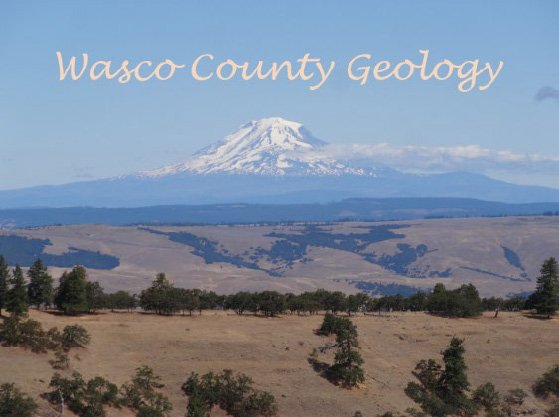Nick Zentner's "2-Minute Geology" of the Kittitas Valley
/GSOC Annual Banquet Recap (Part 2)
Nick Zentner, Senior Lecturer at Central Washington University, Ellensburg, gave a riveting lecture on the geology of the Kittitas Valley at our 79th Annual Banquet this March. Starting out with an old fashioned “chalk talk” on a large blackboard that he rolled in specially for the occasion, Nick first depicted the location of Ellensburg on a hasty but accurate drawing of Washington State. He noted that the subject of his lecture was in the center of the state, using letters to represent other points of reference such as Seattle, Spokane and Tri Cities.
(On the light side, when someone in the audience pointed out that Nick had labeled the Tri Cities area as being in Oregon, he adjusted its location by moving it somewhat to the north. All the while he was drawing, he motioned behind his back towards the audience a gesture which roughly translated to, “Picky, picky, pick-ee!”. This became a focal point of humor throughout the rest of the lecture, where he always made a point of specifically noting the precise location of Tri Cities.)
Nick showed that the Kittitas Valley is a lenticular, elongated valley oriented Northwest to Southeast. This fact becomes important later as he discussed the tectonic forces acting on the area.
The geology of the area was completed in four main stages. The first, occurring during the Cretaceous period was the acquisition onto a young, developing west coast of North America of the accreted terranes. These terranes were large pieces of land that were too buoyant to subduct into the trench of the Juan de Fuca plate as it slides under the North American plate. Nick showed how the terranes were “pasted” onto the continent in layers, one by one, gradually causing the ancient coastline to retreat westward as more land was added on. He noted how these terranes became the “basement” rock to which the rest of the state was resting on.
The second stage was one of volcanism from two main sources. Continuing subduction during the Eocene and into the Miocene brought periods of volcanism. The young Cascades were getting their start, blanketing the area with alternating layers of white ash and lahars of today’s Ellensburg Formation. He was careful to mention that these young Cascades were not the familiar peaks today of Mt Rainier, Mt St Helens, and Mt Adams, but rather older cones that have long since eroded away.
A second form of volcanism had its genesis in great fissures that opened along the boundary of eastern Washington and Idaho, which spewed out tremendous volumes of black lavas collectively called the Columbia River Basalts. Nick pointed out that these younger lavas made their away across the state, building the Columbia Plateau and terminating at the edge of the Kittitas Valley during the Miocene.
In the third stage of development, Nick showed how the whole coast of the Pacific Northwest is being tectonically altered. A network of GPS stations had been installed a decade earlier into the bedrock of areas of North America. Tracking the motion of the various stations by satellite shows that the western part of our continent is rotating around a central point located in today’s Pendleton area. The motion of the warping land is clockwise. Vectors which denote plate motion as arrows show more rotation on the outermost area of the circle as one would expect, while the area around Pendleton is barely moving at all. This tectonic motion has a profound effect on the structure of the landscape, causing the NW-SE up-warped folds of what is called the Yakima Fold Belt. These valleys and ridges, called anticlines and synclines, account for the parallel ridges that characterize the area. Rivers such as the Yakima cut their way through these folds in what is referred to as “gaps”.
The final stage of development is the huge influence that Pleistocene glaciation had on the area. The Cascades were heavily mantled in ice and snow as Alpine glaciers carved out spectacular valleys that are enjoyed today. On an even larger scale, the area was shaped by the great ice sheets that covered North America during the Ice Ages. Although these great masses of ice did not reach as far south as Ellensburg, the outpouring of flood waters from glacial Lake Missoula left a spectacular effect on today’s landscape.
Nick’s blackboard talk was followed up by the recent technology using a Power Point presentation in which he showed images of various scenes from the area. A particular interesting part of the lecture was the use of various short videos from a series that Nick created entitled, “Two Minute Geology”, in which he explains and illustrates the local geology in small vignettes. Decked out with a red bow tie, and strumming a guitar, Nick delights audiences of all types with these informative presentations which can be easily streamed as You Tube videos. Nick’s lecture to GSOC did not fail to entertain and educate all.
Afterward and Additional Reading
Zentner has been with CWU Geology since 1992. He advises geology undergraduates and mentors graduate students teaching in the field and in the lab. Nick teaches a popular "Geology of Washington" course to CWU students every quarter - and his course is open to townspeople for free! He received the 2011 CWU Most Inspirational Faculty Award and the 2012 CWU Presidential Faculty Award. To see some of Nick’s work follow these links: Nick’s Website and 2-Minute Geology.


























































